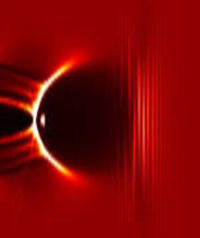
Computer simulation of a micrometer-scale intense X-ray source (small bright blob to the left of centre) created in a laser-plasma accelerator
© Dept of Physics, University of Strathclyde
Laser-driven plasma accelerators derive their energy from a high intensity laser (generally a Ti:sapphire laser) that irradiates a low density plasma target with femtosecond light pulses. The light pulses produce a density wake in plasma thus separating the charge to produce accelerating fields 1000 times stronger than possible in conventional accelerators. The resulting self-injected electrons form ultra-short duration bunches, which can directly produce THz radiation, X-rays or gamma rays up to 10 MeV or through interacting with a secondary target or counter-propagating laser beam produce 100s MeV photons. Radiation produced in laser-plasma interactions include: electrons, muons, protons, neutrons and light ion beams, and electromagnetic radiation pulses from the IR to gamma rays.
The SCAPA facility uses two state of-the-art Ti:sapphire lasers: a 40 TW (1.4 J, 35 fs; at 10 Hz) and a 350 TW (8.75 J, 25 fs; at 5 Hz) system, to generate:
Radiation pulses:
- High brightness THz and infra-red radiation;
- Partially coherent betatron (plasma wiggler) radiation in the X-ray to γ-ray (10s of MeV) range;
- Coherent radiation from a free-electron laser (FEL) in the VUV- X-ray (sub-nm) range.
Particle beams:
- Monoenergetic electron beams of energy 100 MeV – 4 GeV;
- Proton and light ion beams of energy up to 100 MeV/c.